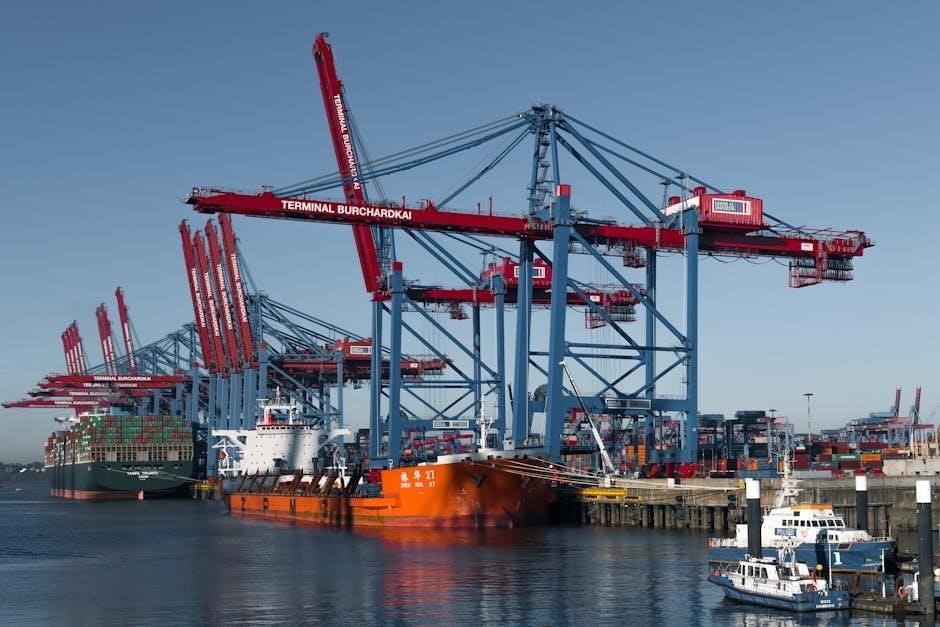Port forwarding is a networking technique enabling external devices‚ like Palworld servers‚ to communicate with your gaming device through your router. It ensures smooth online interactions and is essential for hosting dedicated servers and enabling seamless multiplayer experiences in Palworld.
1.1 What is Port Forwarding?

Port forwarding is a networking technique that allows external devices to communicate with a specific device on a private network by opening specific ports. It creates a direct communication channel between your router and the device running Palworld‚ ensuring smooth online interactions. By forwarding ports‚ you enable incoming traffic to reach your gaming server or client‚ which is essential for hosting dedicated servers and enabling multiplayer connectivity. This process involves creating a rule in your router to direct traffic on specific ports to the internal IP address of your Palworld server or gaming device.
1.2 Why is Port Forwarding Important for Palworld?
Port forwarding is essential for Palworld as it enables seamless multiplayer connectivity and dedicated server hosting. By opening specific ports‚ you allow external players to join your server and ensure stable communication between your device and Palworld’s servers. Without proper port forwarding‚ you may experience connection issues‚ lag‚ or inability to host games. It ensures your router directs incoming traffic correctly‚ making your server accessible to others and enhancing your overall gaming experience. Proper configuration is vital for maintaining a stable and efficient network environment for Palworld;
Steps to Set Up Port Forwarding for Palworld
Access your router settings‚ locate the port forwarding section‚ and create a new rule to forward the necessary ports for Palworld server connectivity.
2.1 Accessing Your Router Settings
To access your router settings‚ open a web browser and enter your router’s IP address in the address bar. Common router IPs include 192.168.1.1 or 192.168.0.1. Log in using the admin credentials‚ often found on the router or in its manual. If prompted‚ enter the username and password (default is typically “admin” for both). Once logged in‚ you’ll access the router’s control panel‚ where you can manage settings like port forwarding. Ensure you’re using the correct IP and credentials for your specific router model. If unsure‚ refer to your router’s documentation or manufacturer’s website for guidance.
2.2 Finding the Port Forwarding Section
After logging into your router‚ navigate to the port forwarding section. This is typically found under “Advanced Settings‚” “Network‚” or “NAT” depending on your router model. Look for options like “Port Forwarding‚” “Virtual Servers‚” or “Gaming.” If you can’t find it‚ consult your router’s manual or online support resources. Once located‚ this section will allow you to create new port forwarding rules‚ essential for enabling Palworld server connectivity. Ensure you’re in the correct section before proceeding to create a new rule for optimal setup.
2.3 Creating a New Port Forward Rule
To create a new port forward rule‚ select the “Add” or “Create” option in the port forwarding section. Name the rule (e.g.‚ “Palworld Server”) for easy identification. Set the protocol to TCP/UDP‚ depending on the game’s requirements. For Palworld‚ use port 8211 as the default. Enter the internal IP address of the device running the server. Ensure the external and internal ports match. Save the rule and restart your router if necessary. This setup ensures incoming traffic on the specified port is directed to your Palworld server‚ enabling smooth connectivity for multiplayer experiences.

Specific Ports Required for Palworld
Palworld requires port 8211 for optimal connectivity. Additional ports may be needed for features like voice chat or custom mods‚ but 8211 is the primary port.

3.1 Listing the Necessary Ports
For Palworld‚ the primary port required is 8211‚ which is essential for server connectivity and gameplay. Additionally‚ ports 27015-27016 may be needed for multiplayer functionality. These ports should be configured using UDP protocol for optimal performance. Ensure your router forwards these ports to the internal IP address of your gaming device or server. Refer to your router’s manual or online resources for specific instructions‚ as settings vary by model. Accurate port configuration ensures smooth online interactions and prevents connectivity issues in Palworld. Testing these ports with online tools can confirm their proper setup and functionality.
3.2 Configuring Port Ranges and Protocols
When setting up port forwarding for Palworld‚ specify the exact ports and protocols required. Use TCP for reliable data transmission and UDP for faster communication. For the main server connection‚ set the external and internal ports to 8211. If additional multiplayer features are needed‚ include the range 27015-27016 using UDP. Ensure the internal IP address matches your gaming device. Properly configuring these settings ensures stable connections and optimal performance. Always verify your router’s documentation for specific protocol and port range options to avoid conflicts and ensure seamless gameplay in Palworld.

Testing Your Port Forwarding Setup
Use online port checkers to verify if ports are open. Test connectivity in Palworld to ensure smooth gameplay and server access after setup.
4.1 Using Online Port Checkers
To verify your port forwarding setup‚ use online port checkers. These tools test if specific ports are open and accessible.

- Visit a reliable port checker website.
- Enter the port number you forwarded (e.g.‚ 8211 for Palworld).
- Start the test to check connectivity.
- If the port is open‚ the tool will confirm successful connection.
- Ensure Palworld server is running during testing for accurate results.
This step ensures your setup is correct and connectivity issues are resolved.
4.2 Verifying Connectivity
After setting up port forwarding‚ verify connectivity to ensure Palworld servers are accessible. Test server accessibility from another network or device to confirm functionality. Use online tools to check if ports are open and functioning correctly. Ensure firewall settings allow traffic on the forwarded ports. If connectivity fails‚ restart your router and server‚ then retest. Double-check your port forwarding rules and server IP address for accuracy. Troubleshoot by testing from a different location or device to isolate issues. Successful connectivity ensures smooth multiplayer experiences and dedicated server hosting in Palworld.
Troubleshooting Common Issues
Identify connection problems by checking port settings and firewall configurations. Ensure correct port numbers and protocols are used. Consult your router’s manual for guidance if issues persist.
5.1 Identifying and Resolving Connection Problems
When encountering connection issues in Palworld‚ start by verifying your port forwarding settings. Ensure the correct ports (e.g;‚ 8211 for Palworld) are open and properly configured. Check if the internal IP address assigned to your gaming device is accurate and static. Use online port checkers to confirm that the ports are reachable. If issues persist‚ review your firewall settings to ensure they are not blocking traffic. Restart your router and server to apply changes. If problems remain‚ consult your router’s manual or seek additional troubleshooting guides specific to your setup.
5.2 Adjusting Firewall and Network Settings
To resolve connectivity issues in Palworld‚ ensure your firewall settings allow traffic on the required ports. Disable any unnecessary restrictions or enable exceptions for Palworld-related ports (e.g.‚ 8211). Check your network settings to ensure UPnP is enabled‚ as it can automatically configure port forwarding. If using a static IP‚ verify it is correctly assigned to your gaming device. Consider using Dynamic DNS for stability if your IP address changes frequently. If issues persist‚ consult your router’s manual or manufacturer support for specific guidance on adjusting firewall and network configurations for optimal Palworld performance.

Additional Considerations
Setting up a static IP ensures your device’s IP remains constant‚ while Dynamic DNS helps manage a changing IP‚ enhancing connectivity and stability for Palworld.
6.1 Setting Up a Static IP Address
To ensure consistent connectivity for your Palworld server‚ setting up a static IP address is crucial. This prevents your device’s IP from changing‚ which could disrupt port forwarding. Access your router’s settings and navigate to the DHCP section. Assign a static IP to the device hosting your Palworld server by reserving its current IP or manually setting it. This step is essential for maintaining stable connections and ensuring that port forwarding rules work effectively. A static IP simplifies troubleshooting and guarantees that your server remains accessible to other players.

6.2 Using Dynamic DNS for Stability
Dynamic DNS (DDNS) enhances stability for your Palworld server by providing a constant domain name‚ even if your public IP address changes. This is particularly useful for hosting servers‚ as it eliminates the need to update players with a new IP address. To set up DDNS‚ register with a DDNS provider‚ configure your router or server to update the service‚ and test the domain. This ensures seamless connectivity and reduces downtime‚ making it easier for players to join your Palworld server without constant IP updates. It’s a reliable solution for maintaining long-term server accessibility.

Port forwarding is essential for optimizing your Palworld experience‚ especially for hosting dedicated servers and ensuring smooth multiplayer interactions. By following the steps outlined in this guide‚ you can configure your router to open necessary ports‚ improve connectivity‚ and reduce lag. Remember to use tools like online port checkers to verify your setup and consider Dynamic DNS for added stability. With proper port forwarding‚ you’ll enjoy a more stable and enjoyable gaming experience in Palworld. Thanks for reading‚ and happy gaming!
